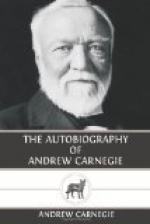The Lucy Furnace became the most profitable branch of our business, because we had almost the entire monopoly of scientific management. Having discovered the secret, it was not long (1872) before we decided to erect an additional furnace. This was done with great economy as compared with our first experiment. The mines which had no reputation and the products of which many firms would not permit to be used in their blast furnaces found a purchaser in us. Those mines which were able to obtain an enormous price for their products, owing to a reputation for quality, we quietly ignored. A curious illustration of this was the celebrated Pilot Knob mine in Missouri. Its product was, so to speak, under a cloud. A small portion of it only could be used, it was said, without obstructing the furnace. Chemistry told us that it was low in phosphorus, but very high in silicon. There was no better ore and scarcely any as rich, if it were properly fluxed. We therefore bought heavily of this and received the thanks of the proprietors for rendering their property valuable.
It is hardly believable that for several years we were able to dispose of the highly phosphoric cinder from the puddling furnaces at a higher price than we had to pay for the pure cinder from the heating furnaces of our competitors—a cinder which was richer in iron than the puddled cinder and much freer from phosphorus. Upon some occasion a blast furnace had attempted to smelt the flue cinder, and from its greater purity the furnace did not work well with a mixture intended for an impurer article; hence for years it was thrown over the banks of the river at Pittsburgh by our competitors as worthless. In some cases we were even able to exchange a poor article for a good one and obtain a bonus.
But it is still more unbelievable that a prejudice, equally unfounded, existed against putting into the blast furnaces the roll-scale from the mills which was pure oxide of iron. This reminds me of my dear friend and fellow-Dunfermline townsman, Mr. Chisholm, of Cleveland. We had many pranks together. One day, when I was visiting his works at Cleveland, I saw men wheeling this valuable roll-scale into the yard. I asked Mr. Chisholm where they were going with it, and he said:
“To throw it over the bank. Our managers have always complained that they had bad luck when they attempted to remelt it in the blast furnace.”
I said nothing, but upon my return to Pittsburgh I set about having a joke at his expense. We had then a young man in our service named Du Puy, whose father was known as the inventor of a direct process in iron-making with which he was then experimenting in Pittsburgh. I recommended our people to send Du Puy to Cleveland to contract for all the roll-scale of my friend’s establishment. He did so, buying it for fifty cents per ton and having it shipped to him direct. This continued for some time. I expected always to hear of the joke being discovered. The premature death of Mr. Chisholm occurred before I could apprise him of it. His successors soon, however, followed our example.




